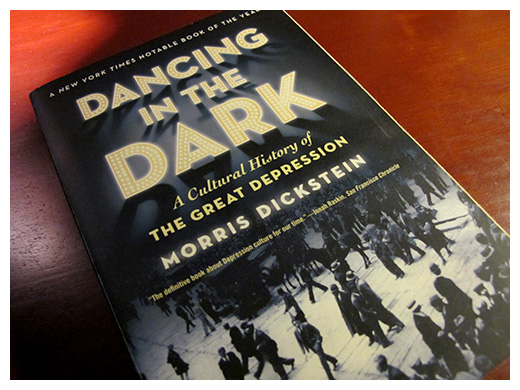Dave Buckhout .
Publication Date: November 8, 2012
 Common enough is the volume found to be exhaustively-researched while maintaining stylistic rhythm: a narrative born of an author’s grinding resolve to deliver lasting work. But rare is the volume that also radiates with a sense that the author enjoyed writing it as much as you did reading it. The bright pace of Morris Dickstein’s “Dancing in the Dark” makes clear that he drank in every ounce of researching and writing this book. Fusing history and the arts, Dickstein slaloms through a wide range of disciplines and results in literature, verse, documentary-work, design, movies, theatre, music, and the various hybrids: musicals, dance, etc., that gushed from an era at once teeming with creative expression and the bone-deep chill of a society on the brink: 1929-1941, The Great Depression.
Common enough is the volume found to be exhaustively-researched while maintaining stylistic rhythm: a narrative born of an author’s grinding resolve to deliver lasting work. But rare is the volume that also radiates with a sense that the author enjoyed writing it as much as you did reading it. The bright pace of Morris Dickstein’s “Dancing in the Dark” makes clear that he drank in every ounce of researching and writing this book. Fusing history and the arts, Dickstein slaloms through a wide range of disciplines and results in literature, verse, documentary-work, design, movies, theatre, music, and the various hybrids: musicals, dance, etc., that gushed from an era at once teeming with creative expression and the bone-deep chill of a society on the brink: 1929-1941, The Great Depression.
The book rolls out as an extended review, Dickstein himself an accomplished arts critic. Its historical and narrative accomplishments were so strong as to inspire beyond the book itself, several glowing reviews (which led me to the book) standing out as great pieces of aesthetic narrative in their own right. It seemed as if nothing short of inspired writing was acceptable in critiquing a work delivering at so high a level. In the end, it is this high-dose infusion of love for the subjects that elevates the book. It should be noted that Dickstein sticks only to those works / personalities from the era that have personal impact. But there is no rule that an author spending so much time with a specific subject can’t pick-and-choose, the end goal to enjoy the hell out of the process—the journey itself. And we should be glad for it; when employed as strategically as in Morris Dickstein’s “Dancing in the Dark,” from author to readers, everybody wins … Here’s a cross-cut of passages marked in the margins of my, now, worn copy:
- “[The 1930s] witnessed the momentous growth of a new kind of popular culture in America: national rather than regional, amplified by technology, creating new folkways in a country still relatively isolated from the world.”
- “The dire economic conditions of the Depression led not only to a political concern for the poor and destitute but to a cultural interest in their lives and traditions.”
- (Referencing Zelda Sayre and F. Scott Fitzgerald, one of the more famous cultural-art-side couples of the era) … “The spectacular and tragic curve of their marriage and his career provided an eerie parallel to the general collapse of the economy and the near total shift of sensibility between the two decades.”
- (Referencing Depression-era writers / artists) … “because so many bright promises made their generation had come to naught, they were drawn to the notion of failure as an inescapable contemporary theme.”
- (On Louis Armstrong) … “With his horn or with his voice, he could relax behind the beat, shadowing it, caressing it, playing hide-and-seek with it.”
- “As the ethos of the jazz scene helped bury America’s small-town puritanism, the modern yet decorative lines of the new design fashions [streamlined Art Deco] made America less traditional and provincial.”
- “[Frank] Capra’s heroes are no exceptional men, but only heightened versions of ordinary good men … their myth is the 1930s myth of the common man.”
- “… despite the economic crisis, the popular art of the 1930s was striking for its lightheartedness and friviolity. This was one of the paradoxes of the decade.”
SOURCE : Dickstein, Morris. Dancing in the Dark, A Cultural History of the Great Depression. New York: W. W. Norton & Company, 2009.
